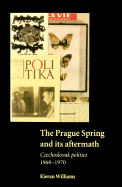Book contents
- Frontmatter
- Contents
- Preface
- List of abbreviations
- Part I Liberalization, intervention, and normalization
- Part II January 1968–December 1970
- 4 The erosion of Soviet trust
- 5 The failure of Operation Danube
- 6 Dubček's normalization
- 7 The realist ascendancy
- 8 The security police in the Dubček period
- 9 After Dubček
- Select bibliography
- Index
5 - The failure of Operation Danube
Published online by Cambridge University Press: 05 July 2011
- Frontmatter
- Contents
- Preface
- List of abbreviations
- Part I Liberalization, intervention, and normalization
- Part II January 1968–December 1970
- 4 The erosion of Soviet trust
- 5 The failure of Operation Danube
- 6 Dubček's normalization
- 7 The realist ascendancy
- 8 The security police in the Dubček period
- 9 After Dubček
- Select bibliography
- Index
Summary
During the night of 20–1 August, under the code-name Operation Danube, an invasion coalition led by the Soviet Union moved 165,000 soldiers and 4,600 tanks into Czechoslovakia from southern Poland, the GDR, and northern Hungary. Within a week, after further contingents arrived, approximately half a million foreign soldiers and more than 6,000 tanks were roaming over Czechoslovak territory. Although they started seizing state offices and utilities, the armies had not been dispatched to establish an occupation government. Their arrival was coordinated (albeit hastily and poorly) with Czechoslovak conservatives and neo-conservatives who had signalled their willingness to take power and fulfil all the promises made by Dubček. Knowing that they could not rely on the support of the pro-reform Czechoslovak army officer corps or of the bewildered security police, these conspirators in Prague and Bratislava needed external intervention, a coup de main to support their coup d'état.
The armed intervention was intended to install a more reliable regime in Prague, intimidate the ‘counter-revolutionary’ forces into submission, and signal to the world that the Soviet Union would only enter détente from a position of strength, with its sphere of influence unassailable and united. Though the Soviets anticipated costs, including the outrage of communists in Western Europe, they calculated (a) that the pay-offs of intervention would be greater than the costs, and (b) that the costs of intervening would be less than those of not intervening.
Information
- Type
- Chapter
- Information
- The Prague Spring and its AftermathCzechoslovak Politics, 1968–1970, pp. 112 - 143Publisher: Cambridge University PressPrint publication year: 1997
